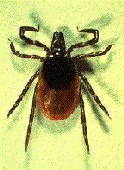
SUNDAY, March 28 (HealthDay News)– Before heading out to enjoy the warm weather, guard yourself against tick-borne Lyme disease, experts advise.
“The main issues with Lyme disease are the time of year [most tick bites occur from April to October], if you live or frequent an area where ticks are prevalent [woods or areas with tall grass populated by deer or other wild animals], and if you remove a tick, to watch out for symptoms, although more than half of patients with Lyme disease did not see the tick,” Dr. Jose Munoz, chief of infectious diseases at Children’s and Women’s Physicians of Westchester in Valhalla, N.Y., said in a news release.
Prevention measures include avoiding tick-infested areas, wearing protective clothing, using tick repellents (up to 10 percent DEET), and checking your body for ticks.
The earliest sign of Lyme disease is a rash, but it doesn’t always occur.
“There can be the classic bull’s eye, sometimes a double bull’s eye, and sometimes just a pink oval rash,” said Munoz, who added that it’s common for the rash to grow in size.
“Any expanding rash or redness needs to be considered suspicious for Lyme; it’s not infrequent for the rash to be mistaken for other common conditions such as ringworm or poison ivy,” he said.
Among other possible symptoms of Lyme disease as it progresses: feeling feverish and “generally not well,” similar to flu-like symptoms without the congestion; neurological signs, such as drooping or weakening of one side of the face; symptoms similar to meningitis, including fever, headache, stiff neck and nausea; joint swelling; and vision problems.
Antibiotics usually cure early-stage Lyme disease.
More information
The U.S. Centers for Disease Control and Prevention has more about Lyme disease.

